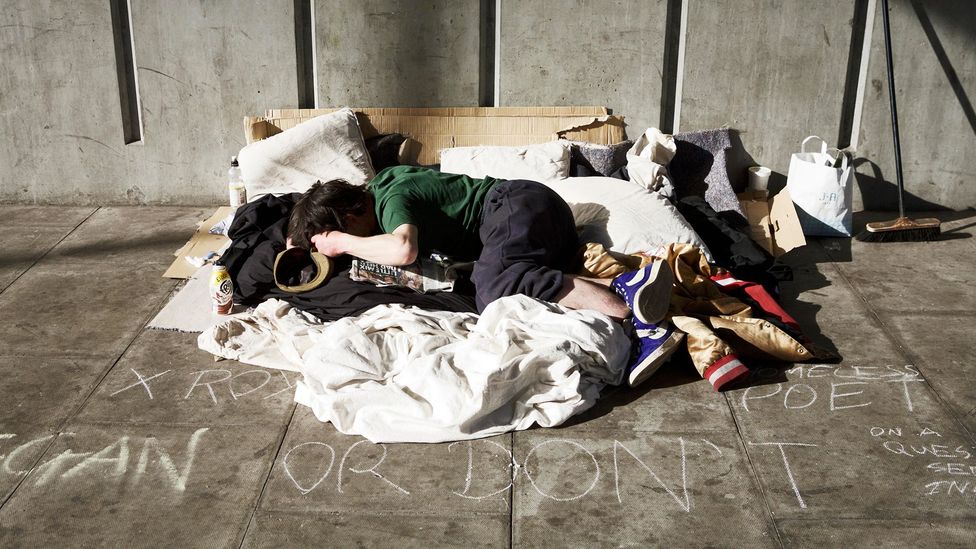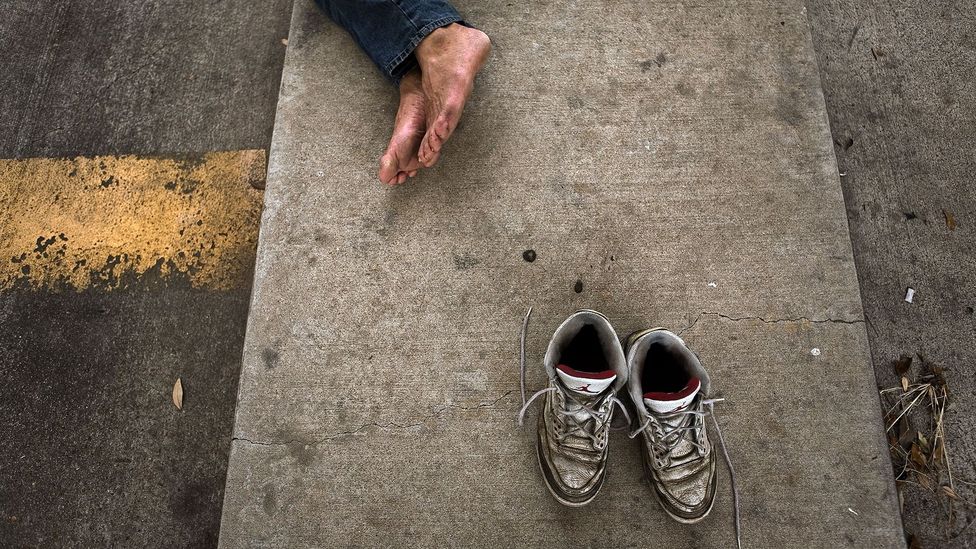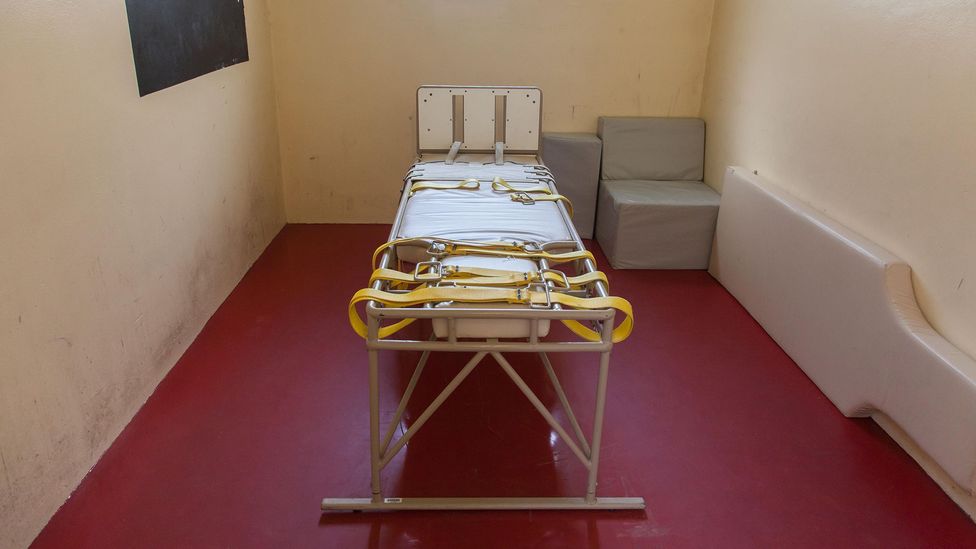How To Get A Delusional Person To Seek Help
How do you treat someone who doesn't accept they're ill?

Some people suffering psychoactive disorders such as schizophrenia have no idea they are ill – and refuse to seek treatment. But if they are not harming others, is it right to force them to seek treatment?
O
On 3 July 2014, Misty Mayo boarded a Greyhound bus bound for Los Angeles. Desperate to escape her hometown of Modesto in Stanislaus County, 300 miles north in California's Central Valley, the 41-year-old thought the 4th of July fireworks in LA would be the perfect antidote.
Even a mugging at the Modesto bus station didn't deter her. When she arrived in LA the next morning with just a few dollars in her pocket, Misty immediately asked a police officer for directions to the fireworks display. She also knew she would need to find a Target pharmacy to refill her medication, but decided it could wait until later.
Later came and went. With no money in a strange city, Misty found the bus system too confusing to navigate. The longer she went without her cocktail of antipsychotics to keep the worst symptoms of her schizoaffective disorder at bay, the more difficult it became to remember that she even needed medication. In the sweltering July heat, Misty roamed the streets of Santa Monica, trying to grab a few minutes of shut-eye where she could. Mostly, she was too afraid to sleep.
Misty's worsening mental state left her combative and paranoid. Her memories of this time are vague at best, but hospital records show a series of psychiatric hospitalisations during July and August. She was arrested at least once. By now, Misty no longer recognised that she had a health problem. Not surprisingly, she didn't take her medications once out of hospital, and the cycle repeated itself over and over.
Back in Modesto, Misty's mother, Linda, felt her worry turn to panic as the days passed without word from her daughter. She filed a missing persons report, and the next time police picked up Misty for her latest infraction, Linda got a phone call. Knowing where her daughter was, however, didn't mean that she could help Misty, and she watched her daughter's deterioration with horror and fear.
You might also like:
- The surprising benefits of electroconvulsive therapy
- The unique way the Dutch treat mentally ill prisoners
- Is there a link between mass shootings and mental illness ?
"There really isn't anything we can do. The only time she's going to get help is if they put her in the hospital, and the only way they'll put her in the hospital is if she's a danger to self or others," Linda says. Wandering the streets and shouting at strangers, without adequate food and water, didn't qualify.
What Misty needed, Linda believed, was a programme that would require her to take the medications that had been helping her in Modesto without having to be admitted to hospital. A bill in California could enforce this, but it had not been passed in Stanislaus County. Known as Laura's Law, the bill allows courts to order what's known as assisted outpatient treatment (AOT) to people with severe mental illness if they meet specific criteria, including previous hospitalisations or arrests, being noncompliant with outpatient treatment, and becoming dangerous to themselves or others.
The law, however, is not without its critics. Civil rights advocates argue that the state shouldn't have the right to deprive someone of their liberties with forced treatment. Some psychiatrists say that AOT simply doesn't work. Linda's quest to get Laura's Law passed in Modesto, together with Misty's experiences in LA, highlight the high-stakes battle to find the best ways to help people with severe mental illness who, like Misty, may not recognise their own condition.
*
As a leading neurologist at the Hôpital de la Pitié in Paris, Joseph Babinski was used to seeing all sorts of unusual phenomena. But in 1914, two patients stuck out. Both had damage to the right hemispheres of their brains, leaving them paralysed on the left side of their body (each brain hemisphere controls the opposite side of the body).
For an experienced neurologist like Babinski, this was hardly noteworthy. What did strike him was that both patients insisted they were completely normal. They were unaware that there was anything wrong with them. In a 1914 medical journal article, Babinski explained that when he recommended electrotherapy to one of these patients, she replied, "Why do you want to electrify me? I am not paralysed." He coined a new word to describe this symptom: anosognosia, literally meaning 'without knowledge'.
Unlike in denial, when an individual knows there's something wrong but insists they're fine, Babinski believed that his patients weren't fibbing or confused; they genuinely had no concept that half their body was paralysed. Something in their brains – he couldn't say what – was damaged. For the next eight decades, anosognosia featured exclusively in the neurology literature, associated with physical conditions. Not until the mid-1990s did a few psychiatrists begin to try and apply the word to their patients, too. The pushback came almost immediately.
The idea that some people with mental illness lack insight into their condition wasn't new. It had been codified in the Diagnostic and Statistical Manual of Mental Disorders (or DSM, psychiatry's bible) for several illnesses, including schizophrenia and anorexia nervosa. But using the word anosognosia was another matter entirely, says Dinah Miller, a psychiatrist at the Johns Hopkins University School of Medicine.
"It's a politically charged word," she says. "When someone uses it, by extension, it has come to mean that they are in favour of legislation to make it easier to treat patients against their will. Instead of being a medical treatment issue, it becomes a civil rights issue."
But for Linda Mayo, the question of her daughter's right to refuse treatment must be balanced against her right to have a roof over her head and food on the table. When she isn't taking her medications, she ends up in jail, which also takes away her civil rights.

Misty's problems began when she moved to Los Angeles (Credit: Alamy)
At a snug ranch in Modesto, just a few streets away from where she raised her family, Linda pulls out a stack of photos. Legs tucked under her long, flowing skirt, Linda flips over photo after photo of what could pass for the all-American family. On top there are faded 1970s baby photos of Misty, curly blonde hair pulled back in pigtails. Then dance classes, sequined costumes, broad smiles. Middle school, her hair darkening to a medium brown, then high-school graduation.
The first sign that something was wrong came as Misty started university. Her mental health took a nosedive. She became paranoid and combative, convinced people were abusing her. She experienced delusions, which psychologists define as unshakable beliefs despite overwhelming evidence to the contrary. Misty's delusions were that she had been raped or had had some sort of medical procedure done while she was unconscious. And she found it impossible to hold a conversation, jabbering on incoherently. These are characteristic symptoms of schizophrenia, a mental illness that affects one in 100 people. It can also bring social and cognitive difficulties.
Despite the initial chaos in her early 20s, Misty did well after being diagnosed and starting medication. Nearly 90% of people with schizophrenia are unable to work, but Misty was a hairdresser for nearly 20 years.
Things started to unravel again at Linda's 60th birthday party in the summer of 2010. That day was the high-water mark in her life, the last time things were OK. She pulls out another photo. "That's it," she says. "That's the last family photo we have."
Misty slowly stopped responding to medication. Her hours at a chain hairdressing salon were cut, making her ineligible for the company's health insurance, which left her unable to pay for a new cocktail of meds that might have kept her symptoms under control. The photos at the bottom of Linda's stack are a dramatic contrast to the smiles at the beginning. Antipsychotic medications led to dramatic weight gain. Misty dyed her hair jet black and her eyes lost their sparkle. She eventually started to refuse outpatient treatment.
"She got to the point where she said, 'I don't want to be here. I don't need these services,'" Linda says.
Misty had run-ins with the police and was taken to hospital, but did not receive the intensive treatment she needed. Her sudden departure to LA made the situation even more precarious.

Until recently, there was no law that compelled people with psychotic conditions to seek treatment (Credit: Alamy)
Linda knew Misty was homeless and unmedicated but had no way to contact her. Even if she did, Misty's insistence that she was fine tied everyone's hands, as the law requires that a person be an immediate threat to themselves or others before they can be committed to an institution for inpatient treatment against their will.
In the end, Misty's repeated arrests would be her salvation. She was remanded to court-ordered outpatient treatment as part of her parole. For the first time in nearly a decade, Misty was stable, on medication and participating in treatment. To Linda, the order of her daughter's legal encounters (first jail, then court-ordered treatment) made no sense. What she wanted was a new first step that would prevent these difficulties.
While Linda was venting at a local support group run by the National Alliance on Mental Illness, another parent asked: "Have you heard of Laura's Law?"
With the development of effective antipsychotic medication in the 1950s and 1960s, many psychiatric hospitals in the US and other countries, including the UK, began shutting their doors. An advertisement for chlorpromazine in a US psychiatric journal boasted that "more patients will be released after shorter periods of hospitalisation and fewer patients will require re-hospitalisation. More patients can be treated in the community, at clinics or in the psychiatrist's office without being hospitalised at all." The change was billed as a more effective and humane way to treat people with mental illness, with the added benefit that community care cost far less than institutionalisation.
Antipsychotics were only one factor in the shift towards deinstitutionalisation, which also included a growing awareness of the civil and human rights abuses that often occurred inside psychiatric hospitals. In 1967, California's then-governor Ronald Reagan signed the Lanterman–Petris–Short Act, a landmark bill intended to halt the "inappropriate, indefinite, and involuntary commitment of persons with mental health disorders, developmental disabilities, and chronic alcoholism". The bill formed the basis of much of the psychiatric legislation for the rest of the US.
What resulted wasn't just a shift away from long-term psychiatric hospitalisation, but also towards giving patients greater control over their own treatment, including the decision whether to receive treatment at all.
In many ways, this transition has been positive for mentally ill individuals, says Carol Stanchfield, programme director at Turning Point Community Programs in Nevada County in north-eastern California. It means patients' rights aren't stripped without due process, and it gives them the opportunity to live among friends and family in the community.
But a major problem was that outpatient treatment was simply not as available as it needed to be. As new legislation narrowed the criteria by which patients could be involuntarily committed, many people affected by mental illness were excluded. Repeated threats of violence were no longer grounds for commitment. The result was that many of the most severely mentally ill were left to fend for themselves on the streets. By the 1980s, one observer noted that a patient's basic rights were "being exercised in a vacuum with none of the attendant supports and backup systems in place to make it viable". Instead of hospitals, many ended up in jail, arrested for nuisance crimes. As a result, the country's prisons have now taken the place of its former mental institutions.
At the time, many psychiatrists failed to appreciate the impact of a person's impaired insight on their ability to accept treatment. But if you don't believe you're sick, why would you see a doctor and pay for often expensive medications that come with a host of annoying and potentially dangerous side-effects?

Antipsychotic drugs were one factor that led to a reduction in the amount of patients being institutionalised (Credit: Alamy)
"The very biggest barrier for these individuals to seek and maintain treatment is anosognosia," says Stanchfield. "They don't recognise that they have an illness. Of course, if they're unaware of their own mental health condition, then they really can't accurately see the need for any treatment."
Stanchfield's office is just down the hall from where, on 10 January 2001, Scott Thorpe walked into the Nevada County Behavioral Health Department and shot three people. Described as "paranoid and reclusive" by neighbours, Thorpe was intermittently receiving county mental health services, but had rejected his family's and social workers' attempts to have him hospitalised. Since he wasn't ruled an immediate danger to others, no one could make him go.
One of the people Thorpe killed was 19-year-old Laura Wilcox. In their grief, her parents searched for something that would help prevent similar tragedies. They found Kendra's Law, named after Kendra Webdale, a 31-year-old who died after being pushed in front of a train by a man with untreated schizophrenia in January 1999. This law in the State of New York allows judges to order psychiatric patients with a history of hospitalisations, treatment noncompliance and severe deterioration to be required to attend outpatient treatment as a condition of continuing to live in the community.
Inspired by Kendra's Law, the Wilcoxes lobbied for the creation of Laura's Law in California. With the state still reeling from the tragedy in Nevada County, the California legislature passed Laura's Law in 2002. One caveat was that each of California's 58 counties would have to approve Laura's Law individually before the law could be enacted in their jurisdiction.
Nevada County was the first in 2008. But only a handful of other counties followed. In Modesto, Linda Mayo wanted Stanislaus County to add its name to the list. Hoping the law would alleviate a small fraction of the worry she had experienced as the mother of a child with a serious mental illness, Linda turned into a one-woman media machine. She wrote countless editorials to the local newspaper and joined Facebook groups to promote her cause. Other families struggling with mental illness joined her, sharing stories of family members who had suffered and died because they were too sick to recognise they needed help.
With a swelling homeless population, many of whom had serious mental illnesses, and against the backdrop of endless mass shootings across the country that were (rightly or wrongly) linked to mental illness, the Stanislaus County Board of Supervisors had plenty of motivation to act. And on 15 August 2017, they did, approving a three-year pilot study of Laura's Law, becoming the 18th county in California to approve it.
But for opponents of mandatory psychiatric treatment, the passage of Laura's Law in Stanislaus County was anything but a victory.
*
The night before her graduation from the University of Pennsylvania, Emily Cutler could no longer fight the feelings of despair that overwhelmed her. As much as she didn't want to die, she also wasn't sure she could go on living.
Cutler took double her usual dose of Xanax to try and make it through the night. The extra drugs made it difficult to walk and talk, and she ended up in the emergency room. Doctors asked her if she was suicidal, and she insisted she wasn't. She was depressed and upset, yes, and as much as she wished she might get hit by a bus, she had no plan to harm herself. The physicians weren't convinced and placed her in a glass room for 10 hours before they committed her involuntarily to a local psychiatric hospital.
For the next 48 hours, Cutler sat in an isolation room, having been strip-searched and forced to take medicine. Eventually, the psychiatrists agreed that she posed no risk to herself and discharged her. To Cutler, the experience of forced treatment was unbearably traumatic.
In the aftermath of her experience, Cutler started a group called Southern California Against Forced Treatment, which argues against Laura's Law and any kind of forced psychiatric treatment. Her goal is to provide support for people traumatised by AOT and inpatient commitment, and she has closely followed the expansion of Laura's Law into Stanislaus County. Cutler specifies that her group isn't anti psychiatry; it opposes only involuntary treatment. She points to what she calls psychiatry's double standard: "When I said I didn't want to be locked up, when I said I didn't want treatment, it was instantly, 'Oh, wow, she's so sick that she doesn't even have insight into her own need for treatment,'" Cutler says.

The lack of outpatient care has meant some patients have fallen between the cracks (Credit: Alamy)
"With any other issue that someone might have, if they don't want a certain type of help for it, or they don't want to take a certain type of action, we don't use that, usually, to further justify, 'Well look, they really need the treatment now, and we can really force it on them.'"
San Diego forensic psychiatrist Nicolas Badre agrees that this can lead to problems: "We have the sense that people don't have insight sometimes, like people seem to make claims or decisions that clearly seem against what we see as reality. It's a different sort of path to go down, because then you sort of assume that everything the patient says [that] doesn't agree with you, that's lack of insight, or anosognosia. And it gives you free range to not listen to the patient. And that's the real danger with it."
In the end, Badre says what makes anosognosia difficult in psychiatry is a lack of neuroscientific data on the topic. "I don't think we have evidence that schizophrenia intrinsically makes the brain have this issue."
Maybe not, argues DJ Jaffe, founder of the think-tank Mental Illness Policy Org and an advocate for the severely mentally ill, but a variety of brain-imaging data shows that the brain of someone with schizophrenia functions differently compared to a neurotypical brain.
"The way I describe it is when you see somebody walking down the street [who thinks] they have a transmitter in their head, it is not because they believe they have a transmitter in their head. They know it. Their illness tells them so. And this is the group who won't accept treatment, and treatment can restore their free will. Being psychotic is not an exercise of free will. It is the inability to exercise free will."
Diagnosing anosognosia does not give anyone, court or physician, the inherent right to mandate someone to treatment. What anosognosia does, Jaffe says, is provide a simple, if hard-to-pronounce, term to explain why so many people with schizophrenia and similar illnesses often behave as if they are unaware that their thinking and behaviour are so dramatically different.
Just as importantly, he says, AOT works. Six years after Kendra's Law was implemented in New York, officials had logged a 77% decrease in psychiatric hospitalisations and a 74% decline in homelessness for people in the AOT programme; incarcerations had dropped by 87%. In 2015, seven years after the implementation of Laura's Law, Nevada County reported that people who had completed the AOT programme spent 43% less time in hospital, 52% less time in prison and 54% less time homeless than before they were treated.

The old psychiatric system kept people in facilities where their medication would be supervised (Credit: Alamy)
In North Carolina, Duke University psychiatrist Marvin Swartz randomised individuals who met AOT criteria to receive either AOT or what he termed "assertive community treatment", the Cadillac of public outpatient treatment, consisting of social services, including help with housing, food and transportation, as well as psychological and psychiatric services. AOT won, and although it wasn't as crushing a victory as advocates may have hoped, Swartz's data showed that longer court orders for up to nine months of regular treatment were associated with better outcomes than three-month orders and less-intensive treatment.
"There is this effect of the court order in terms of issuing warnings and reminders to the patient about adherence to treatment, but there's also a more aggressive attempt by the service providers to make sure the person gets the treatment plan that is intended," he says.
However, when British psychiatrist Tom Burns conducted a trial of AOT in the UK, he found different results. The UK equivalent of AOT is known as a community treatment order, although these are often used as a step down from inpatient care rather than an order in and of themselves. (Involuntary inpatient commitment in the UK is governed by sections of the 1983 Mental Health Act; being held in a psychiatric hospital and treated against your will is commonly known as 'being sectioned'.)
Burns found that community treatment orders had no effect on how well patients did. They weren't hospitalised any less and didn't show any more signs of recovery. This, combined with a meta-analysis of UK and US programmes that showed equivalent results, transformed Burns from an enthusiastic supporter of AOT to a vocal critic.
"I became aware that this intervention that I'd been very keen on for 20 years, actually if you looked in the cold light of day at the evidence, was not a good intervention," he says.
Both sides cite the studies that support their views and criticise the ones that don't. Jaffe says you can't compare the UK results with what AOT is trying to do in the US because community treatment orders and AOT are fundamentally different. Burns, for his part, says that because patients in California and New York aren't randomised to AOT, it's impossible to tell whether they're getting better because they have better services or because of the court order. Randomised controlled trials like the one in North Carolina are unlikely to be repeated, which means that both sides will continue to argue their points from imperfect data.
*
After treatment, the insight that often goes missing during a severe mental illness can return, albeit to varying degrees. A substantial number of patients have no memory of their illness at its peak. Others admit they were truly ill, even if they may share secret doubts that their symptoms were really that bad. Many, like Misty Mayo, fall somewhere in between, with memories that are jumbled and confused. She acknowledges that something was going on, but she can't always remember what, or just how bad it got.
I meet Misty in San Pedro in southern LA. She lives in a group home where she has assistance with daily living, including medication, cooking and other chores. On a brightly brisk early spring morning, we drive the few blocks from her shabby two-storey adobe apartment building in an equally shabby part of town to Cabrillo Beach. Salt breeze in our faces, we sit and watch the skateboarders and picnickers. Misty turns her face to the sun and visibly relaxes. We chat for nearly an hour about her early life, her diagnosis and how she ended up in LA. Finally, I ask what she thinks of involuntary outpatient commitment.

Linda Mayo lobbied lawmakers in the Modesto's county to bring in Laura's Law (Credit: Alamy)
Misty pulls a bag of tobacco out of her purse and rolls herself a cigarette. After lighting it, she takes a long drag and says, "I'm really grateful that I had to get treatment."
Misty tends to ramble and hop from topic to topic without any interlude, although it isn't immediately obvious whether this is due to mental illness or simple loneliness. She has a therapist and a care team, and often texts her mother; she has a boyfriend who genuinely cares for her. But her life isn't perfect. Her apartment is small and her disability income limited. She remains convinced that she has been abused and violated, as well as operated on without her knowledge or consent. If I believed similar events had occurred to me, I think I'd also be fearful and paranoid.
Despite this, Misty is doing alright. She continues to take her prescribed medication every day, although whether that would continue if she wasn't supervised remains anyone's guess.
Misty's parole – and the court-ordered treatment it requires – will expire soon. The date looms large in Linda Mayo's mind. She hopes Misty continues treatment willingly. But she also holds out hope that Laura's Law will be in place to help her if Misty ever becomes unable to continue treatment in the future.
--
This article was first published on Mosaic by Wellcome and is republished here under a Creative Commons licence.
Join 900,000+ Future fans by liking us on Facebook , or follow us on Twitter or Instagram .
If you liked this story, sign up for the weekly bbc.com features newsletter , called "If You Only Read 6 Things This Week". A handpicked selection of stories from BBC Future, Culture, Capital, and Travel, delivered to your inbox every Friday.
How To Get A Delusional Person To Seek Help
Source: https://www.bbc.com/future/article/20180806-how-do-you-treat-someone-who-doesnt-accept-theyre-ill
Posted by: allenclas1974.blogspot.com

0 Response to "How To Get A Delusional Person To Seek Help"
Post a Comment